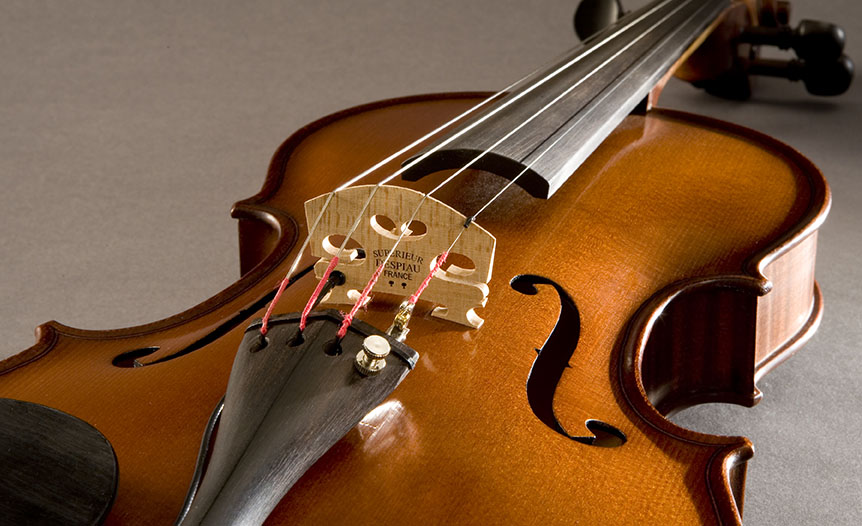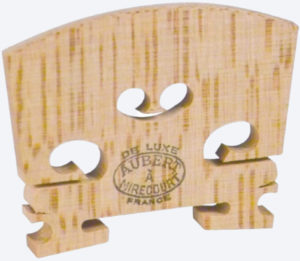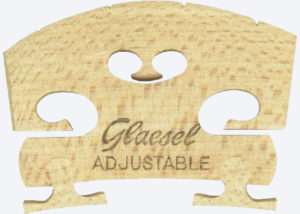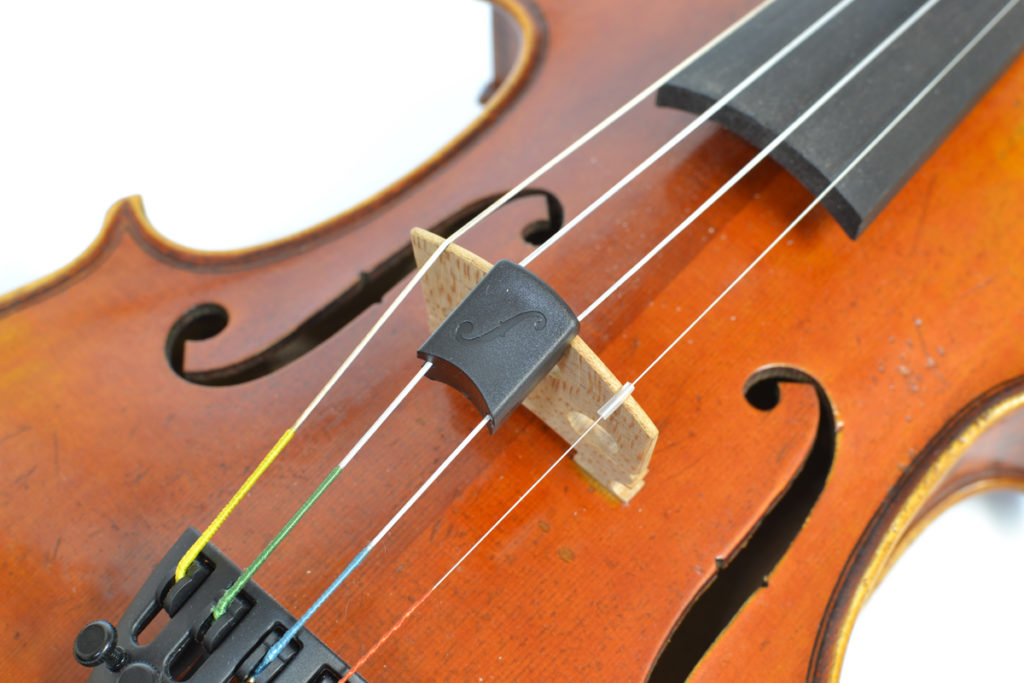A violin bridge lifts and separates the strings so the bow can reach them. As the bow is drawn across the strings, vibration is created. The violin bridge then translates vibrations from those strings into the body of the violin. That vibration resonates within the instrument, producing the beautiful sounds of a sonata or concerto.
The quality and fit of the bridge can make all the difference in the way a violin sounds. Thankfully, this essential piece of the instrument is fairly easy and inexpensive to replace.
A Quick Glance At The Best Violin Bridges 2021:
- Teller Germany 4/4 Semi Fitted Bridge
- Cremona 2-Star ½ Size Violin Bridge
- Sky Fitted 4/4 Maple Violin Bridge
- Aubert De Luxe 4/4 Violin Bridge
- Tourte 4/4 Violin Bridge
- Anton Bréton ¾ Student Violin Bridge
- Longdex 4/4 Violin Bridge
- Jinhui Direct Timiy ¼ Violin Bridge
- Glaesel Adjustable Violin Bridge
- Despiau Superior Violin Bridge
When should you replace a violin bridge?
Obviously, a cracked or broken bridge should be replaced immediately, but there are other, more subtle ways the bridge could be negatively affecting your violin’s sound quality. Even the best made violin will need to have a bridge replacement at least once in its lifetime. Since they’re made of wood, violin bridges are subject to humidity and temperature. They will expand with humidity and shrink in a dry heat. This expansion and contraction over the years can cause the violin’s bridge to warp. A bridge should be flat and straight. Some are made so they appear more pyramid shaped when viewed in profile, but a bridge should never be bent or curved when looked at from the side.
The feet of the violin bridge should fit tightly against the body of the violin. There will be a slight arch to them that matches the curve of your instrument. If there are any gaps at all, the feet need to be adjusted to fit or the violin bridge should be replaced entirely. Gaps between the bridge feet and the body will interrupt the vibrations on their way from the strings to the body and negatively affect the sound quality of your instrument.
How do I choose the best violin bridge?
The links below will take you to the highest-rated bridges available, but how do we know they’re good? Most bridges are made from maple wood. Maple is strong enough to withstand the pressure from the strings without warping and flexible enough to transmit vibrations well. There’s a reason this material has been used traditionally for bridge making. Some violin bridge makers have begun to include an ebony insert. This gives the bridge added support to prevent the E string from digging into the maple. Most are air dried, but some are heated on a hot plate. This is to make the wood more rigid, but such a rapid change in temperature can result in warping if not done carefully. The grain of the wood should be straight and run parallel to the length of the bridge. Many of these bridges are made by craftsmen who have been making essential violin parts for generations, sometimes for over 100 years. The most notable makers are in France, Italy, and Germany and source their maple from Bosnia (also known as the Bosnia-Herzegovnia). But, there are also some terrific makers stateside.
How do I replace a violin bridge?
Providing your own violin bridge when asking for adjustments in a shop will save you money, but if you don’t want the added expense of an installation, violin bridges are fairly easy to install yourself. There are several videos online that will walk you through the process and many of them come from the bridge manufacturers themselves. Be aware that most new bridges are considered ‘blanks’ and will need to be adjusted with a file or other tool so they’re custom fit to your violin.
First, you’ll want to protect the body of your violin by placing a soft cloth underneath the tailpiece. Then, tip and slide out the old bridge. Before placing the new bridge under the strings, make sure that the sound post is not rolling around inside of the instrument. If it’s not firmly in place before installing the new bridge, you may crack your violin! Next, locate the notches in the middle of the F holes. You’ll need to line up the new bridge so that it’s between the two notches. There should be grooves on the arch of the bridge where the strings go. Some violin bridges have an arch that’s slightly higher on one side. The higher side should go under the G string. Settle the strings into those notches as you ease the bridge into an upright position. When the bridge is properly in place, it lines up horizontally with the F hole notches and vertically with the fingerboard. Lastly, you’ll need to adjust the strings. Start by turning the tuning pegs of the outermost two strings first and then work inward. Then, tune your violin as you normally would.
Now that we’ve covered the basics, let’s take a look at some of the highest rated bridges available, their features, and their origins.
Teller Germany 4/4 Semi Fitted Bridge
Click Here for Pricing, Pictures and Reviews on Amazon
Josef Teller has been in the violin-making business for six generations – since the 18th century. They’re located in Bubenreuth, Germany, in the heart of Bavarian culture. The maple they use is sourced from Bosnia. Teller doesn’t cut corners by using laser cutting, kiln drying, or chemicals. Each bridge is carefully crafted and the wood is seasoned for a minimum of five years. This bridge is for a full-sized instrument and includes the ebony insert for the E string. It comes with string notches already in place, so there’s no need to measure and cut them yourself.
Cremona 2-Star ½ Size Violin Bridge
Click Here for Pricing, Pictures and Reviews on Amazon
Starting from the sixteenth century, the region of Cremona, in northern Italy, was where the most famous, highest-quality violins were made. This is where Stradivari got their start. The company, of course, was named after the region. They make several tools for constructing and working on stringed instruments. This particular bridge is for a half-sized violin, which makes it quite suitable for younger students. This one will have to be shaped to fit, but at a price point this low, it’s well worth the effort if you’re handy with simple tools.
Sky Fitted 4/4 Maple Violin Bridge
Click Here for Pricing, Pictures and Reviews on Amazon
As the name indicates, this violin bridge is already pre-cut to fit, with string notches and an asymmetrical arch. It may still need some adjustment, but as one reviewer put it, “All I did was use a nail file on the feet just a little bit and it fits like a glove.” Sky is a recently created company, founded in 1995 and they’re a supplier, rather than a manufacturer. Still, there are many advantages to going with a Sky bridge. The company is located in El Monte, California so if you enjoy supporting a local company, they fit the bill. They’re also family owned, so you can feel good about supporting them. Finally, the low pricepoint on this bridge makes it an excellent choice for beginners.
Aubert De Luxe 4/4 Violin Bridge
Click Here for Pricing, Pictures and Reviews on Amazon
Aubert has one of the best reputations in the industry when it comes to violin bridgemakers. They have been around since 1865 and come from Mirecourt, France. They use European maple from Bosnia, which they naturally cure and age for maximum quality. Aubert actually started making violin bridges before they began to craft violins in 1987. The name Aubert is internationally renowned for their craftsmanship and superior quality violin bridges. Many professional players choose to use this bridge on their finer instruments. Worthy of a concert themselves, the Aubert De Luxe full size violin bridge does come with a little higher pricetag than some others, but it’s made to last.
Tourte 4/4 Violin Bridge
Click Here for Pricing, Pictures and Reviews on Amazon
This full-sized violin bridge is made by the Joseph Teller company out of Germany. It’s made from Bosnian maple and air dried, not rushed. Teller has been around since 1891 and has passed from generation to generation within the same family. It doesn’t come precut, so some adjusting will be needed before it can be fitted onto your violin. Using the old one as a template is a good rule to follow. The vertical stripes and lines on this bridge show that it was cut with the grain of the wood, which makes it stronger and more resilient.
Anton Bréton ¾ Student Violin Bridge
Click Here for Pricing, Pictures and Reviews on Amazon
Anton Bréton makes all sorts of violin parts, from chinrests to tuning pegs, not just violin bridges. So, they know how to make instruments fit together in order to produce the best sound. Their violins have been around for a while and is still one of the top producers of these instruments. The ¾ scale and low price point make this one ideal for students. They produce four sizes of tapered violin bridges, so be sure to check out the full size selection available.
Longdex 4/4 Violin Bridge
Click Here for Pricing, Pictures and Reviews on Amazon
Here is another very affordable violin bridge option, this one from Heilongjiang, China. You’ll see the name of the city stamped into the side of the bridge. The Longdex is for a full-sized violin and needs to be adjusted to fit your specific shape and scale. It is also made from maple. As it’s what’s called a “blank,” it’ll need to be notched and sanded to fit your specific violin. Once you’ve cut it using the old one as a template, make sure it sits at a 45-degree angle to the violin’s body.
Jinhui Direct Timiy ¼ Violin Bridge
Click Here for Pricing, Pictures and Reviews on Amazon
This bridge shares a name with famous violinist Li Jinhui, who was a composer and songwriter in China in the early 20th century. They make several violin parts and are super familiar with all the parts that make your instrument work. This particular bridge is designed for the smallest violins, which can often be difficult to fit. It will still need to be trimmed to fit, adding the string notches and sanding down the feet. This one is made of maple and air dried. The very low price makes this violin bridge not only great for beginning players, but for people who are just getting into the craft of violin making.
Glaesel Adjustable Violin Bridge
Click Here for Pricing, Pictures and Reviews on Amazon
One reviewer put it best when they wrote, “This is a high quality maple bridge with consistent grain in the correct direction – exactly what one would want, other than a winning lottery ticket.” In fact, most people who purchased this violin bridge agree that it’s one of the best. It is made in the United States and about mid-range in price. The bridge comes ready to install, with string groves carved in and swiveling feet to make sure it sits perfectly against the body of your individual violin.
Despiau Superior Violin Bridge
Click Here for Pricing, Pictures and Reviews on Amazon
Despiau Chevalets has been in business for just under 40 years. They’re a family-owned business out of Gimont, a town in the southwest region of France. They source their wood from Bosnia-Herzegovnia, a country on the Balkan Peninsula in southeastern Europe. Despiau makes four levels of violin bridges, the one with the “three tree” stamp being the highest quality. This bridge is for 4/4, full-sized instrument. It’s one of the higher priced violin bridges on this list, but the exceptional craftsmanship and reliability of the brand makes it worth the slightly increased cost.
How can I help other musicians find a good violin bridge?
Once you’ve completed your shopping and have found the violin bridge that fits you and your instrument, you can help your friends and family who enjoy violins find theirs too! In addition to pointing them toward this informative article, sharing it to your social media pages, and using the links on this page, you may consider leaving an Amazon review for your favorite bridge. A lot of customers rely on recommendations from other shoppers when they’re searching for the right products. Share your experiences with them so that they can find the perfect fit too.
















